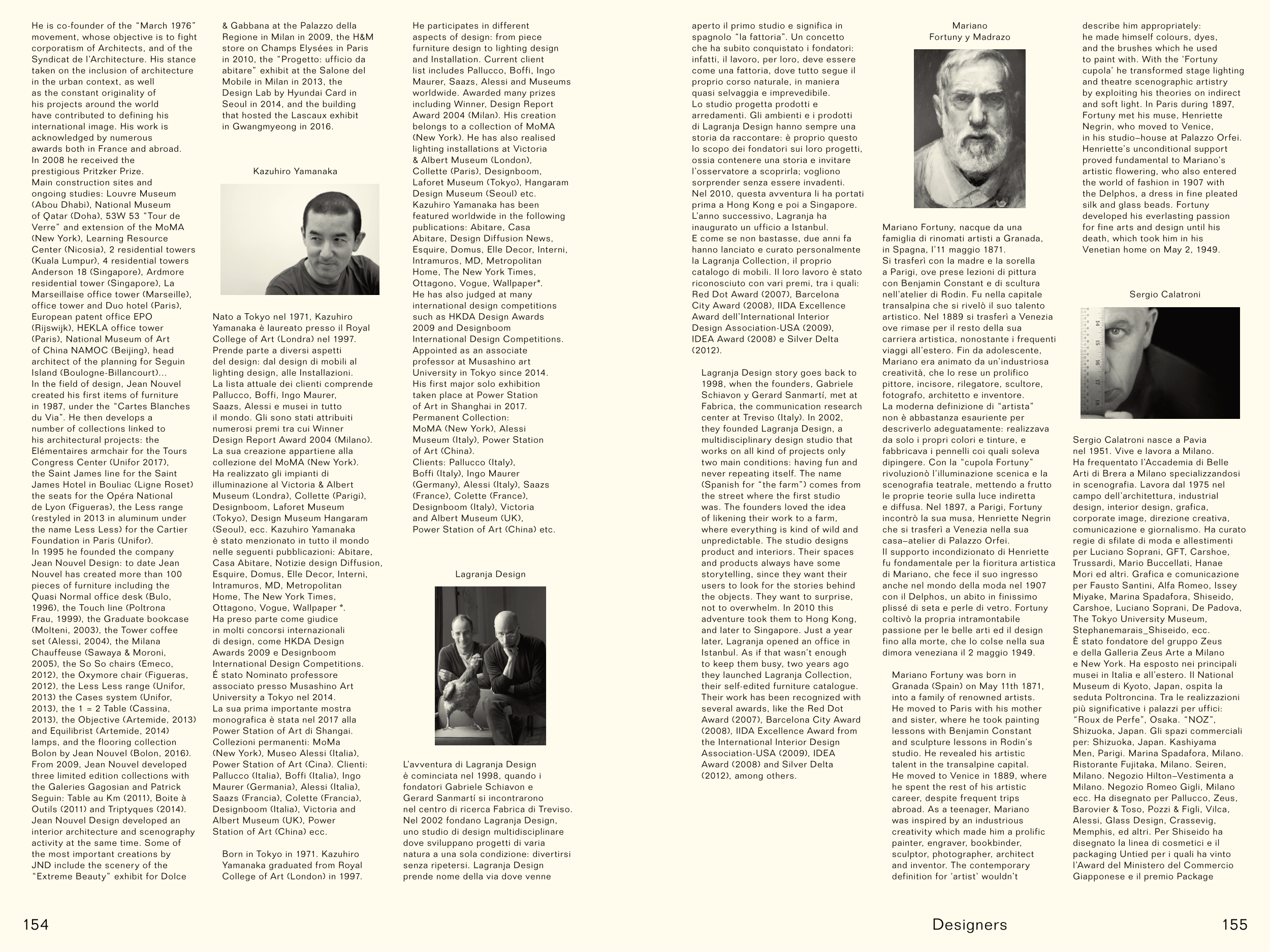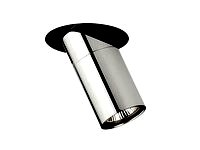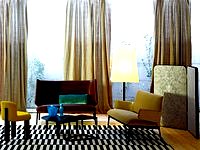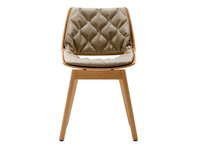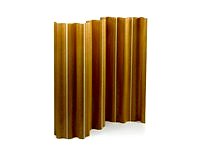154
He is co-founder of the “March 1976”
movement, whose objective is to fight
corporatism of Architects, and of the
Syndicat de l’Architecture. His stance
taken on the inclusion of architecture
in the urban context, as well
as the constant originality of
his projects around the world
have contributed to defining his
international image. His work is
acknowledged by numerous
awards both in France and abroad.
In 2008 he received the
prestigious Pritzker Prize.
Main construction sites and
ongoing studies: Louvre Museum
(Abou Dhabi), National Museum
of Qatar (Doha), 53W 53 “Tour de
Verre” and extension of the MoMA
(New York), Learning Resource
Center (Nicosia), 2 residential towers
(Kuala Lumpur), 4 residential towers
Anderson 18 (Singapore), Ardmore
residential tower (Singapore), La
Marseillaise office tower (Marseille),
office tower and Duo hotel (Paris),
European patent office EPO
(Rijswijk), HEKLA office tower
(Paris), National Museum of Art
of China NAMOC (Beijing), head
architect of the planning for Seguin
Island (Boulogne-Billancourt)…
In the field of design, Jean Nouvel
created his first items of furniture
in 1987, under the “Cartes Blanches
du Via”. He then develops a
number of collections linked to
his architectural projects: the
Elémentaires armchair for the Tours
Congress Center (Unifor 2017),
the Saint James line for the Saint
James Hotel in Bouliac (Ligne Roset)
the seats for the Opéra National
de Lyon (Figueras), the Less range
(restyled in 2013 in aluminum under
the name Less Less) for the Cartier
Foundation in Paris (Unifor).
In 1995 he founded the company
Jean Nouvel Design: to date Jean
Nouvel has created more than 100
pieces of furniture including the
Quasi Normal office desk (Bulo,
1996), the Touch line (Poltrona
Frau, 1999), the Graduate bookcase
(Molteni, 2003), the Tower coffee
set (Alessi, 2004), the Milana
Chauffeuse (Sawaya & Moroni,
2005), the So So chairs (Emeco,
2012), the Oxymore chair (Figueras,
2012), the Less Less range (Unifor,
2013) the Cases system (Unifor,
2013), the 1 = 2 Table (Cassina,
2013), the Objective (Artemide, 2013)
and Equilibrist (Artemide, 2014)
lamps, and the flooring collection
Bolon by Jean Nouvel (Bolon, 2016).
From 2009, Jean Nouvel developed
three limited edition collections with
the Galeries Gagosian and Patrick
Seguin: Table au Km (2011), Boite à
Outils (2011) and Triptyques (2014).
Jean Nouvel Design developed an
interior architecture and scenography
activity at the same time. Some of
the most important creations by
JND include the scenery of the
“Extreme Beauty” exhibit for Dolce
& Gabbana at the Palazzo della
Regione in Milan in 2009, the H&M
store on Champs Elysées in Paris
in 2010, the “Progetto: ufficio da
abitare” exhibit at the Salone del
Mobile in Milan in 2013, the
Design Lab by Hyundai Card in
Seoul in 2014, and the building
that hosted the Lascaux exhibit
in Gwangmyeong in 2016.
Kazuhiro Yamanaka
Nato a Tokyo nel 1971, Kazuhiro
Yamanaka è laureato presso il Royal
College of Art (Londra) nel 1997.
Prende parte a diversi aspetti
del design: dal design di mobili al
lighting design, alle Installazioni.
La lista attuale dei clienti comprende
Pallucco, Boffi, Ingo Maurer,
Saazs, Alessi e musei in tutto
il mondo. Gli sono stati attribuiti
numerosi premi tra cui Winner
Design Report Award 2004 (Milano).
La sua creazione appartiene alla
collezione del MoMA (New York).
Ha realizzato gli impianti di
illuminazione al Victoria & Albert
Museum (Londra), Collette (Parigi),
Designboom, Laforet Museum
(Tokyo), Design Museum Hangaram
(Seoul), ecc. Kazuhiro Yamanaka
è stato menzionato in tutto il mondo
nelle seguenti pubblicazioni: Abitare,
Casa Abitare, Notizie design Diffusion,
Esquire, Domus, Elle Decor, Interni,
Intramuros, MD, Metropolitan
Home, The New York Times,
Ottagono, Vogue, Wallpaper *.
Ha preso parte come giudice
in molti concorsi internazionali
di design, come HKDA Design
Awards 2009 e Designboom
International Design Competitions.
É stato Nominato professore
associato presso Musashino Art
University a Tokyo nel 2014.
La sua prima importante mostra
monografica è stata nel 2017 alla
Power Station of Art di Shangai.
Collezioni permanenti: MoMa
(New York), Museo Alessi (Italia),
Power Station of Art (Cina). Clienti:
Pallucco (Italia), Boffi (Italia), Ingo
Maurer (Germania), Alessi (Italia),
Saazs (Francia), Colette (Francia),
Designboom (Italia), Victoria and
Albert Museum (UK), Power
Station of Art (China) ecc.
Born in Tokyo in 1971. Kazuhiro
Yamanaka graduated from Royal
College of Art (London) in 1997.
He participates in different
aspects of design: from piece
furniture design to lighting design
and Installation. Current client
list includes Pallucco, Boffi, Ingo
Maurer, Saazs, Alessi and Museums
worldwide. Awarded many prizes
including Winner, Design Report
Award 2004 (Milan). His creation
belongs to a collection of MoMA
(New York). He has also realised
lighting installations at Victoria
& Albert Museum (London),
Collette (Paris), Designboom,
Laforet Museum (Tokyo), Hangaram
Design Museum (Seoul) etc.
Kazuhiro Yamanaka has been
featured worldwide in the following
publications: Abitare, Casa
Abitare, Design Diffusion News,
Esquire, Domus, Elle Decor, Interni,
Intramuros, MD, Metropolitan
Home, The New York Times,
Ottagono, Vogue, Wallpaper*.
He has also judged at many
international design competitions
such as HKDA Design Awards
2009 and Designboom
International Design Competitions.
Appointed as an associate
professor at Musashino art
University in Tokyo since 2014.
His first major solo exhibition
taken place at Power Station
of Art in Shanghai in 2017.
Permanent Collection:
MoMA (New York), Alessi
Museum (Italy), Power Station
of Art (China).
Clients: Pallucco (Italy),
Boffi (Italy), Ingo Maurer
(Germany), Alessi (Italy), Saazs
(France), Colette (France),
Designboom (Italy), Victoria
and Albert Museum (UK),
Power Station of Art (China) etc.
Lagranja Design
L’avventura di Lagranja Design
è cominciata nel 1998, quando i
fondatori Gabriele Schiavon e
Gerard Sanmartí si incontrarono
nel centro di ricerca Fabrica di Treviso.
Nel 2002 fondano Lagranja Design,
uno studio di design multidisciplinare
dove sviluppano progetti di varia
natura a una sola condizione: divertirsi
senza ripetersi. Lagranja Design
prende nome della via dove venne
Designers
155
aperto il primo studio e significa in
spagnolo “la fattoria”. Un concetto
che ha subito conquistato i fondatori:
infatti, il lavoro, per loro, deve essere
come una fattoria, dove tutto segue il
proprio corso naturale, in maniera
quasi selvaggia e imprevedibile.
Lo studio progetta prodotti e
arredamenti. Gli ambienti e i prodotti
di Lagranja Design hanno sempre una
storia da raccontare: è proprio questo
lo scopo dei fondatori sui loro progetti,
ossia contenere una storia e invitare
l’osservatore a scoprirla; vogliono
sorprender senza essere invadenti.
Nel 2010, questa avventura li ha portati
prima a Hong Kong e poi a Singapore.
L’anno successivo, Lagranja ha
inaugurato un ufficio a Istanbul.
E come se non bastasse, due anni fa
hanno lanciato e curato personalmente
la Lagranja Collection, il proprio
catalogo di mobili. Il loro lavoro è stato
riconosciuto con vari premi, tra i quali:
Red Dot Award (2007), Barcelona
City Award (2008), IIDA Excellence
Award dell’International Interior
Design Association-USA (2009),
IDEA Award (2008) e Silver Delta
(2012).
Lagranja Design story goes back to
1998, when the founders, Gabriele
Schiavon y Gerard Sanmartí, met at
Fabrica, the communication research
center at Treviso (Italy). In 2002,
they founded Lagranja Design, a
multidisciplinary design studio that
works on all kind of projects only
two main conditions: having fun and
never repeating itself. The name
(Spanish for “the farm”) comes from
the street where the first studio
was. The founders loved the idea
of likening their work to a farm,
where everything is kind of wild and
unpredictable. The studio designs
product and interiors. Their spaces
and products always have some
storytelling, since they want their
users to look for the stories behind
the objects. They want to surprise,
not to overwhelm. In 2010 this
adventure took them to Hong Kong,
and later to Singapore. Just a year
later, Lagranja opened an office in
Istanbul. As if that wasn’t enough
to keep them busy, two years ago
they launched Lagranja Collection,
their self-edited furniture catalogue.
Their work has been recognized with
several awards, like the Red Dot
Award (2007), Barcelona City Award
(2008), IIDA Excellence Award from
the International Interior Design
Association-USA (2009), IDEA
Award (2008) and Silver Delta
(2012), among others.
Mariano
Fortuny y Madrazo
Mariano Fortuny, nacque da una
famiglia di rinomati artisti a Granada,
in Spagna, l’11 maggio 1871.
Si trasferì con la madre e la sorella
a Parigi, ove prese lezioni di pittura
con Benjamin Constant e di scultura
nell’atelier di Rodin. Fu nella capitale
transalpina che si rivelò il suo talento
artistico. Nel 1889 si trasferì a Venezia
ove rimase per il resto della sua
carriera artistica, nonostante i frequenti
viaggi all’estero. Fin da adolescente,
Mariano era animato da un’industriosa
creatività, che lo rese un prolifico
pittore, incisore, rilegatore, scultore,
fotografo, architetto e inventore.
La moderna definizione di “artista”
non è abbastanza esauriente per
descriverlo adeguatamente: realizzava
da solo i propri colori e tinture, e
fabbricava i pennelli coi quali soleva
dipingere. Con la “cupola Fortuny”
rivoluzionò l’illuminazione scenica e la
scenografia teatrale, mettendo a frutto
le proprie teorie sulla luce indiretta
e diffusa. Nel 1897, a Parigi, Fortuny
incontrò la sua musa, Henriette Negrin
che si trasferì a Venezia nella sua
casa–atelier di Palazzo Orfei.
Il supporto incondizionato di Henriette
fu fondamentale per la fioritura artistica
di Mariano, che fece il suo ingresso
anche nel mondo della moda nel 1907
con il Delphos, un abito in finissimo
plissé di seta e perle di vetro. Fortuny
coltivò la propria intramontabile
passione per le belle arti ed il design
fino alla morte, che lo colse nella sua
dimora veneziana il 2 maggio 1949.
Mariano Fortuny was born in
Granada (Spain) on May 11th 1871,
into a family of renowned artists.
He moved to Paris with his mother
and sister, where he took painting
lessons with Benjamin Constant
and sculpture lessons in Rodin’s
studio. He revealed his artistic
talent in the transalpine capital.
He moved to Venice in 1889, where
he spent the rest of his artistic
career, despite frequent trips
abroad. As a teenager, Mariano
was inspired by an industrious
creativity which made him a prolific
painter, engraver, bookbinder,
sculptor, photographer, architect
and inventor. The contemporary
definition for ‘artist’ wouldn’t
describe him appropriately:
he made himself colours, dyes,
and the brushes which he used
to paint with. With the ‘Fortuny
cupola’ he transformed stage lighting
and theatre scenographic artistry
by exploiting his theories on indirect
and soft light. In Paris during 1897,
Fortuny met his muse, Henriette
Negrin, who moved to Venice,
in his studio–house at Palazzo Orfei.
Henriette’s unconditional support
proved fundamental to Mariano’s
artistic flowering, who also entered
the world of fashion in 1907 with
the Delphos, a dress in fine pleated
silk and glass beads. Fortuny
developed his everlasting passion
for fine arts and design until his
death, which took him in his
Venetian home on May 2, 1949.
Sergio Calatroni
Sergio Calatroni nasce a Pavia
nel 1951. Vive e lavora a Milano.
Ha frequentato l’Accademia di Belle
Arti di Brera a Milano specializzandosi
in scenografia. Lavora dal 1975 nel
campo dell’architettura, industrial
design, interior design, grafica,
corporate image, direzione creativa,
comunicazione e giornalismo. Ha curato
regie di sfilate di moda e allestimenti
per Luciano Soprani, GFT, Carshoe,
Trussardi, Mario Buccellati, Hanae
Mori ed altri. Grafica e comunicazione
per Fausto Santini, Alfa Romeo, Issey
Miyake, Marina Spadafora, Shiseido,
Carshoe, Luciano Soprani, De Padova,
The Tokyo University Museum,
Stephanemarais_Shiseido, ecc.
È stato fondatore del gruppo Zeus
e della Galleria Zeus Arte a Milano
e New York. Ha esposto nei principali
musei in Italia e all’estero. Il National
Museum di Kyoto, Japan, ospita la
seduta Poltroncina. Tra le realizzazioni
più significative i palazzi per uffici:
“Roux de Perfe”, Osaka. “NOZ”,
Shizuoka, Japan. Gli spazi commerciali
per: Shizuoka, Japan. Kashiyama
Men, Parigi. Marina Spadafora, Milano.
Ristorante Fujitaka, Milano. Seiren,
Milano. Negozio Hilton–Vestimenta a
Milano. Negozio Romeo Gigli, Milano
ecc. Ha disegnato per Pallucco, Zeus,
Barovier & Toso, Pozzi & Figli, Vilca,
Alessi, Glass Design, Crassevig,
Memphis, ed altri. Per Shiseido ha
disegnato la linea di cosmetici e il
packaging Untied per i quali ha vinto
l’Award del Ministero del Commercio
Giapponese e il premio Package


